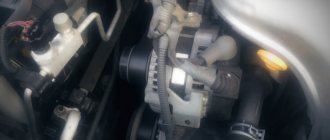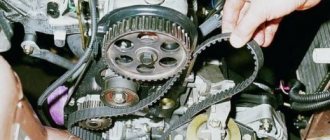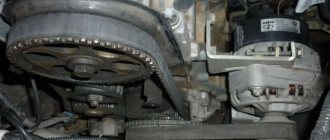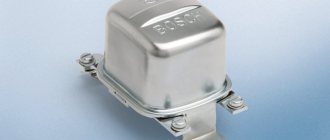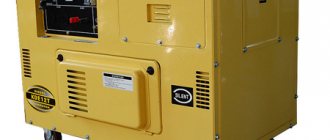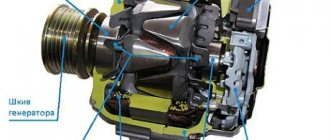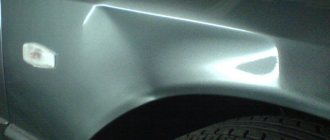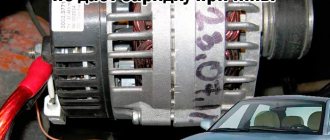It is impossible to operate a car without a generator, since it is responsible for the on-board power supply and electricity generation. GAZelle generator repair is one of the most common restoration work for these cars. The malfunction of this unit is easily determined by disruption of the vehicle and constant discharge of the battery. This is the main reason for the need to contact the service. It is difficult to repair a generator on your own, but it is quite possible if you wish.
Type
The Gazelle generator is a synchronous three-phase machine with electromagnetic excitation and is designed to convert rotational motion into electrical energy. The car is equipped with models 2502.3771 or 9422.3701, the power of which is about 1000 W. Do-it-yourself installation of the generator on the Gazelle is carried out using a mounting bracket on the right side of the power unit. It is driven by a V-belt from the crankshaft ratchet. It works in tandem with a built-in voltage regulator Y212A11E, which maintains the output voltage in the specified operating mode.
Technical characteristics and principle of operation of the generator set
Gazelle 402 and 406 cars are equipped with generator sets, which are a synchronous three-phase electric motor with electromagnetic excitation. The purpose of this device is to convert rotational motion into electricity, which subsequently powers the battery and all electrical equipment of the car. Gazelle Business or Cummins are equipped with generator sets of models 2502.3771 or 9422.3701, their power parameter is around 1000 W.
Briefly about the technical characteristics of the device:
- the unit implements the right direction of shaft rotation;
- the voltage level produced by the device is 14 volts;
- the maximum current value is 72 amperes;
- excitation of the unit at an air temperature of 25 degrees is 1400 rpm;
- at a rotation speed of 1800 rpm, the generator unit will be able to deliver no more than 40 amperes of current, at 5000 - about 70 amperes;
- the resistance value in the excitation winding at an air temperature of 35 degrees is about 2.3-2.7 Ohms;
- The device uses brushes of the M1 brand;
- the number of auxiliary diode elements is 3, and the power limiters for them are 6.
As for the operating principle, it is based on electromagnetic induction. In particular, when a magnetic flux passes through a copper coil installed inside, a voltage appears at its terminals. Voltage values are proportional to the rate at which a given flow changes. It is then necessary for this current to pass through the coil, this will allow it to be converted.
A rotor device is used as a source of alternating field, which consists of a shaft, slip rings, and a pole system. An equally important component is the stator, which is used to generate alternating current. The latter structurally consists of a winding as well as a core.
Possible faults
If the Gazelle generator malfunctions, the operation of all electronic devices is disrupted, and the battery is not recharged. A special indicator on the dashboard informs the driver about the breakdown of this part. With such a malfunction, starting the engine and driving the car is still possible, but until the battery is completely discharged. It is impossible to travel normally in such a car.
The main malfunctions of the generator include the following: violation of the integrity of the charging circuit wires, failure of bearings, damage to the diode bridge, short circuit of the stator winding, breakdown of the voltage regulator, wear of slip rings, excessive wear of brushes.
The Gazelle generator, like any car mechanism, can have both mechanical and electrical damage. Therefore, both the method of repairing the breakdown and the types of operations are different.
Mechanical damage includes wear and damage to rolling bearings, springs, damage to the integrity of the housing, pulley and drive belt.
Faults that are called electrical include breakage of the stator winding, cracks and wear of brushes, breakdown of the relay regulator, melting of the insulating coating of the turns, and interturn short circuits.
In case of any of these types of breakdowns, the car's generator does not fully perform its functions or completely fails, which affects the operation of all electronic devices and the engine as a whole.
Main signs indicating a faulty diode bridge
A normally operating diode conducts current in only one direction. In the event of a breakdown, a current leak appears, which flows from the on-board network to the starter windings. Today, several types of diode bridges are installed on cars:
- diode bridge without additional cooling;
- diode bridge with passive cooling due to special radiators.
In addition, there are different types of connecting windings and connecting bridge platforms: using welding or soldering. The first sign that the generator is operating unstably due to a broken diode bridge is the rapid and frequent discharge of the battery. There are other reasons why you can indirectly determine the combustion of diodes in a rectifier:
- insufficient spark on the spark plugs;
- headlights with dim light during operation of the power unit;
- interruptions in the sound system;
- significant reduction in cooling fan power;
- poor operation of the air conditioning system.
How to remove the generator on a Gazelle?
Now let's consider the issue of dismantling. When carrying out repair operations on a Gazelle car, removal of the generator must be carried out in accordance with all technological instructions and follow safety rules when carrying out work. If the car engine is hot, you need to let it cool down to avoid the possibility of getting burned.
If there is a malfunction of the generator, it is removed from the car engine and diagnostic and repair operations are carried out. To do this, you can contact service workshops or carry out repairs yourself. Many car enthusiasts who encountered this problem for the first time are wondering how to change the generator on a Gazelle. The operation of removing and installing this part is not a complex technological or repair process, and can be done at home. To do this you will need a standard set of tools.
Tuning
Gazelle engine tuning
Engine tuning, your advice and questions
External tuning of the Gazelle
External tuning of the gazelle
Internal Tuning
Internal tuning of a gazelle
Car audio and TV equipment
Everything about car audio in cars and everything connected with it. Installation recommendations, questions, tips.
Tuning other parts of the Gazelle car
Removal process
Before replacing the generator on a Gazelle, it is important to remove the negative one, thereby de-energizing the car’s network, and also disconnect the electrical wires from the part. Next, you need to loosen the belt tension using a special mechanism and remove it. Then, having unscrewed the two mounting bolts of the generator from the engine crankcase, we remove the generator itself from the engine compartment.
If the brushes fail, replacing them will not be difficult.
You just need to unscrew the two screws securing the brushes and remove them from the body. But in case of more serious malfunctions, the element must be disassembled and a detailed analysis of the faults.
Causes of malfunctions
Normal corrosion, wear and moisture can cause a variety of problems. Replacing the belt tensioner gazelle zmz 405 - youtube. Mechanical breakdowns often occur due to prolonged use of the vehicle and material fatigue, the use of low-quality materials in the manufacture of the generator, non-compliance with the operating conditions of the product and disruption of normal operating conditions, under the influence of external factors such as dust, moisture, elevated temperatures and salts.
Disassembly
This section describes a step-by-step process that will help you correctly disassemble the Gazelle generator.
So, first you need to remove the plastic protective cover from the case. Then unscrew the brush block and the voltage regulator, having first disconnected the wiring from it. Next, you should unscrew the four tie rods of the generator housing and remove the housing cover together with the stator. Then, having disconnected the winding terminals from the diode bridge, you need to remove the stator, and, if necessary, the
You can carry out the process of diagnosing generator parts using measuring instruments: E236 or a special test light.
Dismantling the generator
You can dismantle the ZMZ 406 generator from the power plant with your own hands. To do this, you will need a key for 10 and 12. Then you can perform the necessary dismantling operations:
- Remove the negative terminal from the battery.
- We unscrew the wires that are connected to the generator.
- Unscrew and loosen the belt tensioner.
- We remove the belt. If the belt is not planned to be changed, then it can only be removed from the pulley of the generator itself.
- Unscrew the nuts securing the unit to the bracket.
- Pull out the fixing bolts.
- We remove the generator.
With the part removed from the car, you can now begin diagnosing the problems. First you need to disassemble the unit. Remove the back cover, remove the voltage regulator and pulley. Next, unscrew the coupling bolts of the generator covers and remove the stator. If necessary, the rectifier can also be removed.
First you need to diagnose the brush assembly and voltage regulator. As practice shows, it is precisely these parts that often have malfunctions. If everything is in order with the parts, then it is worth checking the stator, rotor and coil winding. Usually, if these components are faulty, they can be replaced. But, if a winding or more than two parts have failed, then it is advisable to purchase a new ZMZ 406 generator, since repairing the old one can cost much more.
It is impossible to imagine a modern car without a battery. This is a vital element in every car. It is this that allows you to start the engine, as well as provide the necessary voltage to maintain its operation. Without a battery, lighting devices would simply not work. But the battery is such a thing that tends to discharge. Without charging, the car can travel no more than one hundred kilometers. Of course, there is no point in charging the battery every couple of hours. Therefore, the design of any car includes a generator for these purposes. "Gazelle Business 4216 UMZ" is no exception. We will tell you in detail about this element on the Gazelle in our article today.
Checking the condition of parts
Regardless of which generator is installed on the Gazelle, the causes of the malfunction, as a rule, can be of the same nature.
They should not have chips or cracks; when pressed with a finger, they should freely sink into the channels of the brush holder, and return to their original position under the influence of a spring.
The length of the brushes should not be less than 4 mm, and if there is severe wear, they are replaced with new ones.
The stator is checked for short circuits between the turn windings and the housing.
This is done by connecting one terminal of the control light to the housing, and the second is alternately connected to one of the three terminals of the turns. In this case, if there is a short circuit to the housing, the indicator light will light up. Having discovered this type of malfunction, it is eliminated or the stator is completely replaced.
To check the stator for a short circuit between the turns, a test lamp is alternately connected to the two terminals of the windings. Moreover, if the light bulb lights up, then there is no break in the turns.
The generator rectifier unit should be cleaned of dust and dirt deposits. Next, you should check the diodes using a test lamp. Due to the fact that diodes of different polarities are placed in each section, they are checked with different battery connection polarities. If a faulty unit is detected, it is replaced.
Check Features
contacts To carry out a comprehensive check of the diode bridge, two tools are enough - a digital combined instrument (multimeter) and a light bulb with a rated voltage of 12 Volts. It is possible to do all the work yourself, without the involvement of expensive craftsmen. To gain access to the assembly, remove the protective housing, and then disconnect the regulator output. In this case, take into account the color characteristics of the diodes:
- Red rectifiers are “plus”.
- Black rectifiers are a minus.
There are two ways to check the integrity of diodes on a VAZ. For greater reliability, it is recommended to use them in combination.
First, let's look at how to test a diode bridge with a multimeter. This option takes the least time and is most in demand among car owners. The algorithm is as follows:
- Remove the rectifier group from the generator. Unfortunately, it will not be possible to perform the test without removing the device from the car. This is because each diode must be tested individually. If they are “in the circuit,” it is unlikely that it will be possible to accurately diagnose the breakdown.
- Switch the digital device switch to dialing mode. After this, connect the probes to each other - you will hear a squeak from the special speaker of the device. If you are using a simple device that does not provide this option, move the switch to the “1 kOhm” position.
- “Sit down” with probes to the input and output of the diode, and then record the indicator. Next, do the reverse measurement. The rectifier can be considered intact if one measurement shows infinity, and another shows 0.5-0.7 MOhm. In the case when in both cases the minimum resistance is displayed on the device, or it shows infinity in the first and second options, this indicates a malfunction of one (group) of diodes.
Now let's look at how to check a diode bridge with a light bulb? This option is good when you don’t have a multimeter at hand. The role of the “device” in this case is played by a 12-volt light bulb.
The algorithm is like this:
- Connect the negative terminal of the battery to the diode bridge. At the same time, make sure that the plate is in close contact with the outer part of the generator.
- Check each diode individually. Take one terminal of the lamp and connect it to the “minus” of the generator, and the second to the “plus” terminal number “thirty” (from the battery). If the light comes on, this indicates problems with one or more diodes. In addition, the glow often indicates the presence of a short circuit in the circuit.
- Check the negative diodes. To do this, connect the negative light bulb to the generator casing, and the other wire to the mounting bolt on the bridge. If during such a check the lamp blinks or glows, there are problems with the “minus” group.
- Check the positive diodes. To do this, place the positive terminal on the “thirtieth” terminal, and the negative terminal on the mounting bolt. There should be no glow from the lamp. If such a problem occurs, there are failures in one or more “positive” diodes.
- Check the additional rectifier group. Take the negative edge and leave it in its original position, and apply the positive end to the sixty-one terminal. The glow of the light indicates a problem.
If checking the diode bridge shows a malfunction, take the broken diode and replace it with a new (serviceable) part. The optimal and simpler option is to purchase the entire diode bridge as a set, but in this case you will have to spend more money.
If you follow the recommendations mentioned above, diagnosing a fault takes no more than 1-2 hours. So don’t rush to the service station - do the work yourself. This way you can gain experience and save your personal budget.
Checking the generator after repair
After a detailed inspection and replacement of defective elements, the generator is assembled. Assembly occurs in reverse order. After the Gazelle generator is assembled, it is important to carry out diagnostics. The serviceable condition and correctness of its assembly can be determined by checking the rotation speed, during which the generator delivers a current of 40 A and 70 A. Diagnostics are carried out on a special stand. The electric motor of the testing stand smoothly changes the rotor speed. At the same time, the generator’s performance is measured, and the degree of its serviceability is determined.
Video “Diagnostics and repair of a generator device”
How to check and repair the unit yourself - the video below provides detailed instructions indicating the main points of this process (the author of the video is Channel 13).
In any car, the generator performs two important functions - it provides all consumers with the necessary electricity and recharges the battery. The Gazelle generator produces electrical alternating current, and the constant voltage required for the on-board network is achieved using a rectifier.
A lot depends on the performance of the energy source - it is impossible to operate a car with a faulty generator.
Installing a dynamo on the engine
Installation on the engine is carried out in compliance with a certain technological process.
First, unscrew the fastening nuts of the generator brackets to the crankcase. Next, install the dynamo and secure the front mounting bolt. Then we move the front bracket and achieve alignment of the crankshaft ratchet with the drive flywheel of the part and the pump drive. By moving the bracket, we achieve elimination of the gap between the generator loop. Install the rear mounting bolt and firmly tighten the mounting nuts of the brackets to the engine crankcase. Next, we put the drive belt on the pulleys and tighten it using a tension bracket. We carry out a control check of the tightness of all threaded connections. We connect the part to the car's electrical network and put the terminals on the battery.
Therefore, solving such an issue is not particularly difficult, and besides, the process itself takes a small amount of time. You can save a lot on auto mechanic services.
Checking the generator on a car
After installing the part in place, you need to start the car engine. Next, you need to turn on the maximum number of electrical appliances available in your vehicle (interior heater fan, wipers, car radio, interior lighting) and turn on the headlights. In this case, even at idle engine speed, the voltage in the on-board network should be 13.8 V. With this indicator, operating the car will not cause any problems.
So, we found out how to change the generator on a Gazelle.
An initial express check of the generator can be performed directly on the car.
All methods for checking the diode bridge of a generator on a VAZ with your own hands
diode bridge The importance of the generator (including in VAZ cars) is difficult to overestimate.
Together with the battery, it provides the voltage necessary for the normal operation of the main systems and “small” car receivers (radio, headlights, etc.). It is known that the battery powers consumers before starting the engine, and the generator is connected to operation after, simultaneously recharging the battery. A diode bridge is a device installed at the generator output that ensures normal operation of the device. If it breaks down, the generator is unable to perform its functions, and the entire load goes to the battery. The battery capacity lasts for 5-6 hours, after which the car is not able to move independently.
Checking the generator on cars with a ZMZ-402 engine
On cars with engines ZMZ-4025 and ZMZ-4026, generators 16.3701 or 191.3701 are installed, not equipped with a built-in voltage regulator. These generators operate in conjunction with an external transistor voltage regulator type 13.3702-01 or 50.3702, which has electronic protection against short circuits in the generator excitation winding circuit.
It is more convenient to do the work together.
We start the engine, let it run for a few minutes, then, pressing the gas pedal, bring the crankshaft speed to 3000 rpm. We turn on the consumers: high beam headlights; heater fan; wiper; emergency alarm. In this mode, we measure the voltage at the terminals of the battery, which should be above 12 V. If this is not the case, the generator windings are faulty (open or short), the voltage regulator with the brush assembly, the slip rings are oxidized or oiled, the brushes are worn out or “stuck.” In order to verify that the voltage regulator is faulty, turn off all consumers except the side lights and measure the voltage at speeds of 1000...1200 rpm, which should be within 13.8...14.5 V.
2. Connect a voltmeter or test lamp to terminal “W” of the block and the body of the voltage regulator. Turn on the ignition
If there is no voltage (the lamp does not light), one of the following malfunctions is possible: failure of contact of the excitation winding with the slip rings; break of the excitation winding; “hanging” of brushes in the channels of the brush holder; burning, oxidation and severe wear of the rotor contact rings.
Description of the generator
The ZMZ 406 generator is an electrical unit that provides stable voltage to the on-board network, as well as charging the battery during engine operation. The part is not difficult to repair and maintain. It ensures full functionality of vehicle electrical circuits. Mainly installed on cars produced by Gorky Automobile, "Volga"). There is also an option for installation on old GAZ-24 and 31 vehicles.
The generator rotates to the right using a V-belt, which is driven by the rotation of the crankshaft. The latter is connected to the generator shaft by pulleys. The rotation speed is 1400 rpm. The maximum speed mode is 5000 rpm.
The output current rating is 14 volts and the power is 70 A. The field coil resistance ranges from 2.3 to 2.7 ohms. It is worth noting that the ZMZ 405-406 generator is the same parts and can be interchangeable. However, the manufacturer recommends installing the one that came from the manufacturer.
Checking the generator on cars with an engine type ZMZ-405, ZMZ-406
On engines of the ZMZ-406 and ZMZ-405 families, generators 9422.3701 or 5122.3771 with built-in integrated voltage regulators are installed.
We start the engine, let it run for a few minutes, then, pressing the gas pedal, bring the crankshaft speed to 3000 rpm. We turn on the consumers: high beam headlights; heater fan; wiper; emergency alarm. We measure the voltage at the terminals of the battery, which should be above 12 V. If this is not the case, the generator windings are faulty (break or short circuit), the voltage regulator with the brush assembly, the excitation winding rings are oxidized or oiled, the brushes are worn out or “stuck.”
In order to verify that the voltage regulator is faulty, we turn off all consumers except the side light and measure the voltage at 1000...1200 min -1, which should be within 13.5...14.2 V.
The removed voltage regulator can be checked as follows. We connect a lamp (21…35 W, 12 V) between the brushes. We connect +12 V to the “D” terminal, and “minus” to the “ground” terminal. The lamp should light up, and when the source voltage increases within 13.5–14.2 V, it should go out. If the lamp lights up in both cases, replace the regulator.
To check the diodes of the rectifier unit and additional diodes, see “ Removing and repairing the generator". If its elements fail, we recommend replacing the rectifier unit as an assembly. It is possible to replace individual diodes, but they will need to be repressed into the holder - an operation that requires care and skill.
Page 1 of 3
Checking and replacing brushes and voltage regulator on vehicles with engines of the ZMZ-405, ZMZ-406 type
On engines of the ZMZ-406 and ZMZ-405 families, generators 9422.3701 or 5122.3771 with built-in integrated voltage regulators are installed.
In order to verify that the voltage regulator is faulty, we turn off all consumers except the side light and measure the voltage at 1000...1200 min -1, which should be within 13.5...14.2 V.
Connect a 12V test lamp to the brushes.
Apply a voltage of 12 V “+” to the terminal, and “-” to the “ground” of the brush holder.
In this case, the control lamp should light up.
If the control lamp does not light, the voltage regulator must be replaced.
The voltage regulator is made in a single housing with a brush holder.
Disconnect the battery.
Disconnect the wires from the generator terminals, remove the plug from the generator plug terminal.
| 1. Use a 10mm wrench to unscrew the nut | 2. Remove the capacitor wire ends from the “+” terminal of the generator. |
| 3. Use an 8 wrench to unscrew the capacitor mounting nut. |
In any car, the generator performs two important functions - it provides all consumers with the necessary electricity and recharges the battery. The Gazelle generator produces electrical alternating current, and the constant voltage required for the on-board network is achieved using a rectifier.
A lot depends on the performance of the energy source - it is impossible to operate a car with a faulty generator.
Replacing and adjusting the tension of the accessory drive belt
Use a 12mm wrench to loosen the bolt securing the tension roller (for clarity, the engine radiator has been removed).
We loosen the belt tension by turning the tension roller bolt counterclockwise with a key “10”
Remove the belt from the pulleys
Installing a new belt.
By rotating the tension roller bolt, we achieve a belt deflection of 15 mm under a load of 8 kgf applied in the middle of the horizontal drive branch (between the generator and pump pulleys).
Tighten the tension roller mounting bolt.
Gazelle generator circuit
The generator on Gazelle cars is a synchronous three-phase electric machine, in the excitation windings of which electric current is generated. The rotor (armature) rotates in the housing and is located inside a constant magnetic field, which is created by the stator (winding). Electricity is generated here as follows:
- when the engine starts, the movement is transmitted from the crankshaft through the drive belt to the generator set pulley;
- the rotor begins to rotate together with the pulley, a magnetic field arises between the stator and armature windings;
- due to electromagnetic induction, EMF is generated, alternating current appears;
- a diode bridge, consisting of diodes of different polarities, rectifies the electric current, making it constant;
- then the current from the rotor commutator is transferred to the brushes and supplied to the relay regulator;
- The regulator limits the voltage, ensuring safe operation of consumers.
The Gazelle generator circuit is very simple; the assembly consists of the following parts:
- case, it is made of two halves - aluminum front and back covers;
- fixed winding - stator;
- rotating shaft - rotor (armature);
- pulley and impeller;
- diode (rectifier) bridge;
- two bearings on which the armature rotates;
- brush assembly;
- relay regulator (voltage regulator).
It should be noted that the voltage regulator is not located directly on the generator on all Gazelle models; on cars with a ZMZ-402 engine, the relay regulator can be mounted on the side member.
Node diagnostics
Let's consider the diagnostic process using the example of the ZMZ-402 engine; the verification procedure should be carried out with an assistant:
- First you need to start the engine and wait until it warms up a little. Press on the gas so that the engine speed increases to 3 thousand per minute.
- Then turn on the electrical equipment, in particular, the optics (high beam), the stove, the wipers, and the light alarm.
- When the consumers are started, the voltage at the battery terminals is diagnosed. The voltage value in this case must be more than 12 volts, otherwise the control device, windings, brushes, and rings should be checked. The brushes could wear out over time and the slip rings could oxidize. To more thoroughly check the functionality of the regulator relay, you need to turn off all equipment and leave only the side lights. At engine speeds of about 1000-1200 per minute, the voltage value should be around 13.8-14.5 volts.
- If you want to check the excitation circuit of the unit, you must disconnect the connecting connector from the control device. Then the voltmeter probes with control are connected to the terminal Ш of the connector, as well as to the relay body.
- Next, the ignition is activated. If the light does not light, then perhaps the reason lies in poor contact of the winding with the slip rings or a break in the excitation winding. Also, such a malfunction may be caused by freezing brushes or inoperability of the slip rings of the rotor mechanism. The latter could oxidize, burn, or simply wear out (the author of the diagnostic video is Evgeniy Shevin).
Types of Gazelle generators
The type of generator installed on Gazelle commercial vehicles depends on the engine model - the first GAZ-3302 vehicles had two types of engines:
- ZMZ-402;
- ZMZ-4063.
The second generation of Gazelles began to be equipped with ZMZ-405 and Chrysler 2.4 engines; Gazelle Business cars, produced since 2010, are equipped with UMZ-4216 and Cummins engines, respectively, and other types of generator devices are installed on them.
Generators come in different capacities and are capable of producing currents of different magnitudes. The standard current source is calculated with a small power reserve, but additional electricity consumption is not taken into account here. Additional energy consumers can be:
- electric windows;
- electrical antenna:
- audio system;
- air conditioner;
- additional cooling fan in the cabin;
- additional heater motor.
If the generator turns out to be weak, it will not be charged enough, which may result in the battery being discharged. Therefore, in many cases, Gazelle owners try to install a more powerful current source - the car will not suffer in any way from the power reserve. For gazelles, there are generators that produce current 65/75/90/100/115/120/135 Amperes. There is a misconception that if the power of the generator device is high, the electrolyte in the battery may boil. But this is incorrect - the generator produces current depending on the load, and the excess voltage is limited by the relay regulator. A powerful generator has only two drawbacks:
- such an electric machine has a higher price;
- a dimensional unit may not always fit in size.
The generator, like any other part in the car, tends to break down; there are several types of malfunctions:
- charging disappears completely;
- there is an “undercharge”;
- high voltage appears in the network (more than 14.7 Volts);
- the generator starts to make noise.
There can be several reasons for the noise:
- bearings are worn out or defective;
- the drive belt has defects;
- The belt tension is weak, and therefore a whistle occurs;
- the impeller touches the belt or generator housing;
- pulley damaged;
- The generator fastener came loose.
If the voltage in the vehicle's on-board network is higher than the permissible norm, there is only one cause of the malfunction - the relay regulator has failed. For the same reason, there may be an undercharge - the voltage regulator does not cope with its functions.
If there is not enough charging, or it is completely absent, there may be several reasons for such problems:
- the brushes in the brush assembly are worn out;
- there are breaks or short circuits in the armature winding;
- these same defects are present in the stator winding;
- The diode bridge is faulty.
On a Gazelle car, the generator can be repaired quite easily, but if there are too many defects in it (for example, the rotor and stator are faulty at the same time), it is easier to buy a new unit and replace it.
Smoking room
General forum
Simple communication between fellow club members, discussion of past days, events, etc.
Tips for choosing a car
Questions about buying a car, engines, body, etc., both new and used
Routes
Description of roads, navigation assistance, checkpoints, detours
Auto News
Incidents, events, premieres and much more. Leading Automotive publications.
There are two power sources in a car - a battery and a generator. The first powers the electrical circuit when the engine is not running. The second is when the engine is already running. In this case, the battery goes into electric current consumer mode and replenishes the energy expended to start the engine.
In practice, malfunctions of one or another power supply are quite common. They often manifest themselves in the same way. The starter refuses to spin the engine, and as a result the engine does not start. When the engine is running, the warning light on the instrument panel with the battery icon lights up. It indicates that a malfunction has occurred and the battery is not charging.
Alternator belt Gazelle
On Gazelle cars, the alternator belt drives the generator, thereby ensuring rotation of the rotor, thereby generating the electrical current necessary for the on-board network. Different engine models are equipped with different types and sizes of belts:
- ZMZ-402 – toothed or smooth poly-V belt, size – 10x1030 mm;
- UMZ-4216 - the same type as on the ZMZ-402 motor, size - 13x1040;
- ZMZ-406 (405) with power steering - multi-ribbed type, length - 1420 mm;
- ZMZ-406 (405) without power steering - multi-stream type, 1220 mm;
- Chrysler – poly-V-type, 1750 mm;
- Cummins 2.8 – multi-stream type, 1226 mm.
Depending on the engine model and manufacturer, alternator belts can vary in price; over time, they wear out and must be replaced. Since the belt drive also ensures the rotation of the water pump, when the generator belt is too tight, noise appears from the bearings of the pump and the generator itself. You can’t do a very weak stretch either:
- charging disappears;
- the water pump pumps weakly, and accordingly, the engine begins to overheat;
- A very unpleasant belt whistle appears.
For Gazelle and Sobol cars, generators are produced by different manufacturers, the most well-known companies are:
- ELDIX (Bulgaria);
- PRAMO-ISKRA (city of Rzhev);
- KZATE (old name KATEK, Samara);
- BATE (Belarus).
In 2020, generators for GAZ commercial vehicles cost on average from 4,000 to 9,000 rubles; the cost of the unit largely depends on the manufacturer, engine model and the power of the generator itself. The most expensive parts are for the Cummins turbodiesel, prices for spare parts range from 8 to 15 thousand rubles, the most expensive are original production parts. The ZMZ-402 generator produced by KZATE for 65 Amperes is relatively inexpensive - on average 4.5-5 thousand rubles.
Generator replacement
The entire generator unit on a car is changed in the following cases:
- if many parts in the device require replacement, and repairing the unit is not economically profitable, it is easier and cheaper to buy a new generator;
- you need to go on a flight urgently, and there is no time to do repairs;
- a new generator is installed, and the old one is repaired and put away as a reserve - it is a backup.
The difficulty of replacing the generator unit also depends on the engine model, but on any engine the work is done quite quickly, since it is still simple on all brands of Gazelle cars. The easiest way is to replace the generator on a car with a 402 engine; we carry out the work as follows;
- After tensioning the belt, we secure the bolts and nuts to the end - they are now located under the generator, and getting to them is somewhat more difficult.
To fasten the generator securely, you need to install two nuts on the bolts, and be sure to lay it between the bolt and the nut along the engraver - on ZMZ-402 motors (as well as on UMZ-4216), vibration-proof fasteners tend to unscrew.
If the bearings in the generator wear out, noise (hum) appears in the generator unit. It is possible to drive with such noise for a while, but it is not advisable, and you cannot delay repairs for a long time - the bearings can jam and burn out. Bearings are always replaced on a removed generator, and in order to replace it, the generator assembly must be disassembled. You can do this kind of work yourself, but keep in mind that the bearings are pressed in and will require a special puller to dismantle them. The rear bearing is rigidly pressed onto the rotor shaft, and it is practically impossible to do without a puller.
In some cases, the bearing in the front housing cover boils tightly, and in this case it is easier to replace it together with the cover.

